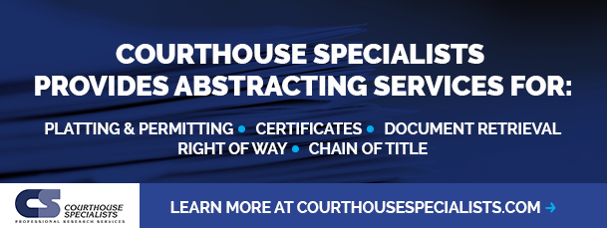
Do you know if your deed includes an easement or right-of-way? If so, it can limit the ability for you to conduct work on the land owned by a private party. Rights-of-way and easements are both examples of property rights, and can allow others the use of your property. In order to remove them from your deed, both parties need to agree.
It is essential you find these items on your deed before you move forward with a project. If you are a landman, an oil or gas company, a title company, or any other entity that may need access to land, understanding the difference between an easement and right-of-way will be beneficial.
What is an Easement?
An easement is an agreed-upon use of land by a party other than the landowner. This agreement allows access to land for things like natural resources, development of necessary utility pipelines, or construction and maintenance. Easements can be beneficial depending on their purpose. It is important to educate yourself on any easements on the property you are interested in to ensure it will benefit you.
There are two different types of easements.
- Gross easement: This allows the use of property without the benefits of ownership. This means the right to use the land is given to a particular individual instead of the property, itself. An example of this is if a homeowner needs to use a walkway through a neighbor’s yard to get to their home. The gross easement belongs to the homeowner. When their home is sold, the easement rights are transferred to the new property owner. The limitations of this type of easement are typically determined by the property owner on which the easement resides. They come up with terms for the individual using the easement and can change them at any time. In the above example, the property owner with the walkway agrees the neighbor can use the walkway on their property, but may include a condition that they use only the walkway and not the yard.
- Appurtenant Easement: This type of easement is issued to adjoin lands. This easement transfers to whomever is the property owner. Typically, the parcel of land with more property is the dominant in the agreement. It is important to find out why this easement is included with the land and how that will affect your business.
What is Right-of-Way?
A right-of-way allows another individual to travel through your property. This benefits another person or another parcel of land you do not own. This grants access to anyone who may need to travel through your land. This is broader than a gross easement in the sense it does not apply to one specific person. The right-of-way is the right for anyone to pass through a portion of your land that may be considered public.
An Easement or Right-of-Way Can Affect Your Property Value
Another reason to be on the lookout for easements or rights-of-ways is their effects on your property values. Several easements on your land may decrease the number of building sites. Future buyers may not like the idea that there is an easement on the property.
There are also some situations where an easement is not currently in use, which could be used as a means to entice you towards a property. Just because the easement is not currently in use does not mean that it won’t be used in the future. Pay close attention to the types of easements and rights-of-way and determine if they will affect your business.
You Can Use Easements and Rights-of-Way to Benefit Your Business
Depending on your type of business, an easement on a property may benefit you. If there is land where you need to include a power line, an easement on the land that is already determined will allow you to do so.
If you are building a housing development, an easement on your land may allow you to build a water storage facility. This may be a part of a future homeowner’s land, but the easement will allow it to be maintained.
These type of easements will be included in the deed of land. It is important to know how to locate these types of easements and determine what will be most beneficial for your company.
Online Deed Research
It is important to utilize online resources when researching deeds. If a deed you are interested in lists a gross easement, appurtenant easement, or a right-of-way, it is important to research them and determine the specifics of those conditions. Here are some steps to ensure you have all of the details.
- Review the deed. Sometimes easements and rights-of-way can be hard to locate. Typically, they can be found in the legal description of the property.
- Contact the county for more information on the easements. They should be able to give you more details about the easements and show you specific plot maps regarding the deed in question.
- Educate yourself on the requirements and restrictions of the easements on the deed. This will help you if the easements are ever in question.
- Research the property and any of its past uses. This will give you a better idea of how an easement or right-of-way has been used in the past and how it may impact you in the future.
Be Prepared
Always be aware of the limitations and requirements of your easements or rights-of-way. This will prepare you in the event an easement on your current property is being challenged. Your business may also be faced with needing to use an easement the property owner does not think you should be using. Knowing the ins and outs of the deed and property will prepare you for these situations.
You may require legal council depending on the situation. There is a fine line with property owners and easements, and it is imperative you make sure you are always in the legal right. If you are unsure of a situation or think you might have a right to use an easement on a property, contact legal counsel that will ensure you are making the right call.






















